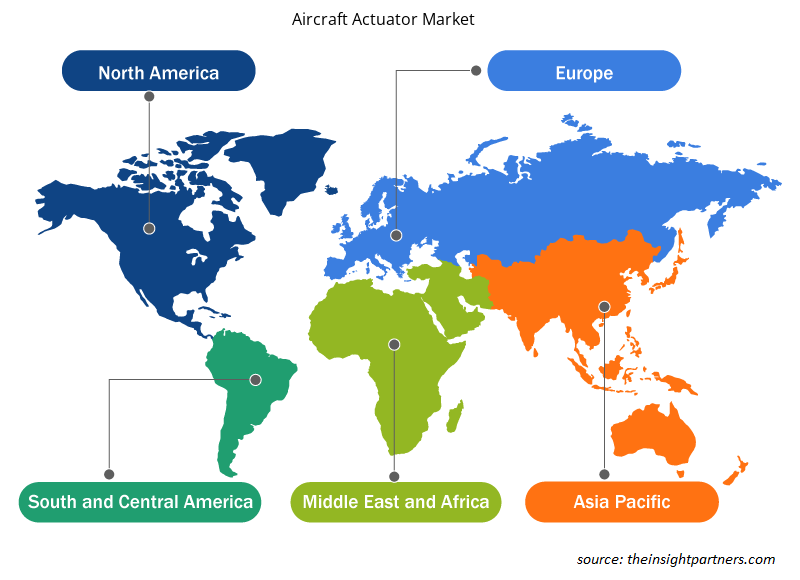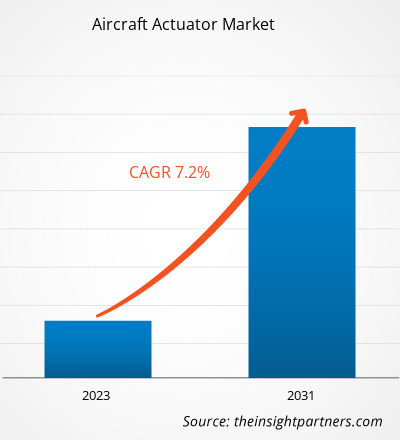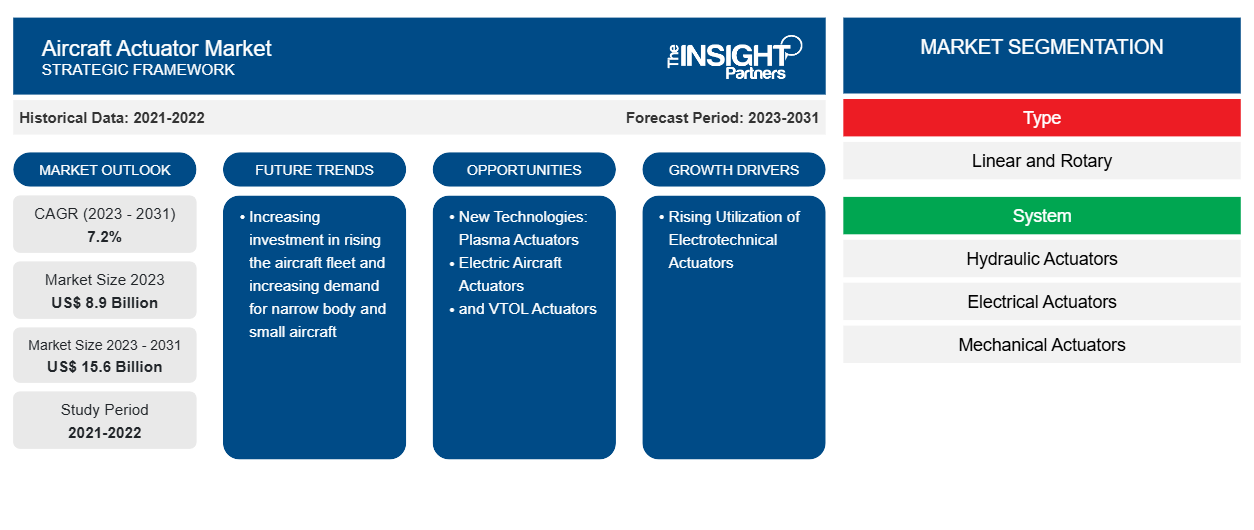Der Markt für Flugzeugantriebe soll von 8,9 Milliarden US-Dollar im Jahr 2023 auf 15,6 Milliarden US-Dollar im Jahr 2031 anwachsen. Der Markt soll zwischen 2023 und 2031 eine durchschnittliche jährliche Wachstumsrate von 7,2 % verzeichnen. Zunehmende Investitionen in die Vergrößerung der Flugzeugflotte und die steigende Nachfrage nach Schmalrumpf- und Kleinflugzeugen zählen zu den wichtigsten Antriebsfaktoren für den Markt für Flugzeugantriebe.
Marktanalyse für Flugzeugantriebe
Das Wachstum des Marktes für Flugzeugantriebe wird vor allem durch erhebliche Investitionen in fortschrittliche Technologien in der Luftfahrtindustrie vorangetrieben. In den letzten zwanzig Jahren ist die Luftfahrtindustrie (kommerziell und militärisch) erheblich gewachsen. Die Geschwindigkeit des technologischen Wandels war herausragend, was die Nachfrage nach verschiedenen Produkten und Dienstleistungen erhöht hat. Aufgrund der steigenden Nachfrage nach verbesserten Flugsteuerungssystemen und Fahrwerken werden zunehmend Flugzeugantriebslösungen in Verkehrsflugzeugen eingesetzt. Die zunehmende Zahl von Flugzeugunfällen und die Verbesserung der gesetzlichen Sicherheitsstandards haben die Bedeutung von Flugzeugantrieben unterstrichen. Um das Leistungsniveau zu verbessern, werden in Flugzeugen fortschrittliche elektromechanische Antriebssysteme eingesetzt. Elektromechanische Antriebe verzeichnen auf dem Markt ein erhebliches Wachstum, da Flugzeughersteller immer mehr elektrische Systeme in Flugzeuge integrieren. Darüber hinaus unterstützen Fortschritte bei Flugzeugsteuerungssystemen wie Digitalisierung und Internet of Things (IoT)-Konnektivität das Marktwachstum.
Marktübersicht für Flugzeugantriebe
Die Flugzeugantriebsbranche entwickelt sich kontinuierlich weiter und bietet Innovationen im Produktangebot, um kleinere, leichtere und kostengünstigere Antriebssysteme bereitzustellen. Die steigende Nachfrage nach elektromechanischen Antrieben zur Verbesserung der Antriebsprozesse treibt das Marktwachstum voran. Das Aufkommen von Elektroflugzeugen bietet den Marktteilnehmern eine neue Möglichkeit, sich auf die Entwicklung leichterer, kleinerer und effizienterer Flugzeugantriebe zu konzentrieren. Darüber hinaus treibt die steigende Nachfrage nach Klein- und Schmalrumpfflugzeugflotten aus Entwicklungs- und Industrieländern das Marktwachstum voran. Die zunehmende Elektrifizierung von Flugzeugsystemen mit Hybridformulierung unter Verwendung mechanischer und hydraulischer Systeme fördert das Wachstum des Marktes für Flugzeugantriebe.
Passen Sie diesen Bericht Ihren Anforderungen an
Sie erhalten kostenlos individuelle Anpassungen an jedem Bericht, einschließlich Teilen dieses Berichts oder einer Analyse auf Länderebene, eines Excel-Datenpakets sowie tolle Angebote und Rabatte für Start-ups und Universitäten.
-
Holen Sie sich die wichtigsten Markttrends aus diesem Bericht.Dieses KOSTENLOSE Beispiel umfasst eine Datenanalyse von Markttrends bis hin zu Schätzungen und Prognosen.
Treiber und Chancen auf dem Markt für Flugzeugantriebe
Steigender Einsatz elektrotechnischer AktorenElectrotechnical Actuators
Flugsteuerungssysteme für Flugzeuge wechseln von sperrigen, schweren und undichten Hydrauliksystemen zu elektrischen autonomen Systemen. Die Fortschritte bei elektromechanischen (EM) Aktuatoren, wie Zuverlässigkeit, Kompaktheit, geringes Gewicht und Kosteneffizienz, führen zu einer zunehmenden Verbreitung in Flugzeugen. Kommerzielle und militärische Flugzeugflotten suchen nach fortschrittlichen Systemen, die leichter sind, um die Kraftstoffeffizienz zu verbessern. Aktuatoren in Flugzeugen werden unter anderem für die Funktionalität von Fahrwerken , Vorflügeln und Spoilern, Sitzen, Klappen, der Positionierung von Triebwerksleitschaufeln, Seitenrudern, Querrudern und dem Öffnen und Schließen von Fracht- oder Waffenschachttüren verwendet. Da Flugzeughersteller zunehmend Wert auf leichte Flugzeugmodelle legen, ziehen elektromechanische Aktuatoren im aktuellen Szenario OEMs an, was den Markt für Flugzeugaktuatoren belebt. Ein weiterer Grund für die zunehmende Verbreitung elektromechanischer Aktuatoren ist der Paradigmenwechsel der Luft- und Raumfahrtindustrie hin zu Elektroflugzeugen, der die hydraulischen, pneumatischen und mechanischen Systeme überflüssig macht und die Verbreitung elektrischer Aktuatorsysteme fördert. Dieser Trend führt zu einer erheblichen Nachfrage nach elektrischen Antrieben, was letztlich dem Markt für Flugzeugantriebe Auftrieb verleiht.electromechanical (EM) actuators, such as reliability, compact nature, lightweight, and cost-efficiency, are mounting its adoption in aircraft. Commercial and military aircraft fleets are looking for advanced systems that are lighter in weight to enhance fuel efficiency. Actuators in aircraft are used in the functionality of OEMs are increasingly emphasizing lightweight aircraft models, electromechanical actuators are attracting OEMs in the current scenario, which is catalyzing the aircraft actuators market. Another reason for the increasing adoption of electromechanical actuators is the paradigm shift of the aerospace industry toward electric aircraft, which is obsoleting the hydraulic, pneumatic, and mechanical systems and is increasing the adoption of electric actuation systems. This trend is generating substantial demand for electrical actuators, which is ultimately boosting the aircraft actuators market.
Neue Technologien: Plasma-Aktuatoren, elektrische Flugzeug-Aktuatoren und VTOL-Aktuatoren
Die Branche der Flugzeugantriebe hat sich von pneumatischen und hydraulischen Antriebssystemen zu elektrischen Antriebssystemen entwickelt. Da die Flugzeugflotte auf saubere Energiequellen umsteigt, steigt in der Luftfahrtindustrie die Nutzung elektrischer Energie, um die Emissionen zu reduzieren. Das Aufkommen von Elektroflugzeugen schafft einen neuen Trend zu elektrischen Antrieben auf dem Markt. So erhielt das Unternehmen Curtiss-Wright im Dezember 2020 den Auftrag, die primäre Flugsteuerungsantriebstechnologie für Alices vollelektrisches Pendlerflugzeug bereitzustellen. Das Unternehmen bietet ein handelsübliches (COTS) EMA-Design an, das leichter und kostengünstiger ist und das Programmrisiko reduziert. Darüber hinaus sind hydraulische und pneumatische Systeme sperriger, was das Gewicht erhöht und zu einem höheren Kraftstoffverbrauch führt. Daher verwendet die Flugzeugindustrie leichte elektrische Antriebe, um den zusätzlichen Kraftstoffverbrauch durch schwere Systeme zu reduzieren.Curtiss-Wright company received the order to provide primary flight control actuation technology for Alice's all-electric commuter aircraft. The company is offering a commercial-off-the-shelf (COTS) EMA design that is lighter, cost-effective and reduces the program risk. Further, hydraulic and pneumatic systems are bulkier, which increases the weight and results in increased fuel consumption. Hence, the aircraft industry is using lightweight electric actuators to reduce additional fuel consumption caused by heavy systems.
Segmentierungsanalyse des Marktberichts für Flugzeugantriebe
Wichtige Segmente, die zur Ableitung der Marktanalyse für Flugzeugantriebe beigetragen haben, sind Typ, System und Endbenutzer.
- Basierend auf dem Typ wurde der Markt für Flugzeugantriebe in lineare und rotierende unterteilt. Das lineare Segment hatte im Jahr 2023 einen größeren Marktanteil.
- Basierend auf dem System wurde der Markt für Flugzeugantriebe in hydraulische Antriebe, elektrische Antriebe, mechanische Antriebe und pneumatische Antriebe unterteilt. Das Segment der pneumatischen Antriebe hatte im Jahr 2023 einen größeren Marktanteil.
- Auf der Grundlage des Endverbrauchers wurde der Markt in Verkehrsflugzeuge und Militärflugzeuge segmentiert. Das Segment der Verkehrsflugzeuge hatte im Jahr 2023 den größten Marktanteil.
Marktanteilsanalyse für Flugzeugantriebe nach Geografie
Der geografische Umfang des Marktberichts für Flugzeugantriebe ist hauptsächlich in fünf Regionen unterteilt: Nordamerika, Europa, Asien-Pazifik, Naher Osten und Afrika sowie Südamerika.
Nordamerika hat den Markt für Flugzeugantriebe im Jahr 2023 dominiert. Die Region Nordamerika umfasst die USA, Kanada und Mexiko. Die Luft- und Raumfahrtindustrie in Nordamerika ist aufgrund der Präsenz einer großen Anzahl von Flugzeugherstellern, Anbietern fortschrittlicher Antriebstechnologie und einer qualifizierten Belegschaft gereift. In der Region besteht eine enorme Nachfrage nach neuen Steuerungssystemen, da Endverbraucher wie Hersteller von Militär- und Verkehrsflugzeugen über neuere Technologien gut informiert sind. Aus diesem Grund ist die Einführung elektrischer und hydraulischer Flugzeugantriebslösungen in Verkehrsflugzeugen hoch und wird zunehmend in neue Schmalrumpfflugzeuge integriert, die von Flugzeugherstellern entwickelt werden. Der kommerzielle Luft- und Raumfahrtsektor in Nordamerika wird hauptsächlich von Boeing dominiert, das auch eine breite Palette von Antrieben in seine Modelle B787 und B777 integriert, um die Flugsteuerung zu verbessern.
Regionale Einblicke in den Markt für Flugzeugantriebe
Die regionalen Trends und Faktoren, die den Markt für Flugzeugantriebe im Prognosezeitraum beeinflussen, wurden von den Analysten von Insight Partners ausführlich erläutert. In diesem Abschnitt werden auch die Marktsegmente und die Geografie von Flugzeugantrieben in Nordamerika, Europa, im asiatisch-pazifischen Raum, im Nahen Osten und Afrika sowie in Süd- und Mittelamerika erörtert.

- Holen Sie sich die regionalen Daten für den Flugzeugantriebsmarkt
Umfang des Marktberichts über Flugzeugantriebe
| Berichtsattribut | Details |
|---|---|
| Marktgröße im Jahr 2023 | 8,9 Milliarden US-Dollar |
| Marktgröße bis 2031 | 15,6 Milliarden US-Dollar |
| Globale CAGR (2023 - 2031) | 7,2 % |
| Historische Daten | 2021-2022 |
| Prognosezeitraum | 2023–2031 |
| Abgedeckte Segmente |
Nach Typ
|
| Abgedeckte Regionen und Länder |
Nordamerika
|
| Marktführer und wichtige Unternehmensprofile |
|
Marktteilnehmerdichte: Der Einfluss auf die Geschäftsdynamik
Der Markt für Flugzeugantriebe wächst rasant, angetrieben durch die steigende Nachfrage der Endnutzer aufgrund von Faktoren wie sich entwickelnden Verbraucherpräferenzen, technologischen Fortschritten und einem größeren Bewusstsein für die Vorteile des Produkts. Mit steigender Nachfrage erweitern Unternehmen ihr Angebot, entwickeln Innovationen, um die Bedürfnisse der Verbraucher zu erfüllen, und nutzen neue Trends, was das Marktwachstum weiter ankurbelt.
Die Marktteilnehmerdichte bezieht sich auf die Verteilung der Firmen oder Unternehmen, die in einem bestimmten Markt oder einer bestimmten Branche tätig sind. Sie gibt an, wie viele Wettbewerber (Marktteilnehmer) in einem bestimmten Marktraum im Verhältnis zu seiner Größe oder seinem gesamten Marktwert präsent sind.
Die wichtigsten auf dem Markt für Flugzeugantriebe tätigen Unternehmen sind:
- Collins Luft- und Raumfahrt
- Cutiss-Wright Corporation
- Eaton Corporation Plc
- Honeywell International Inc.
- Meggitt PLC
- Moog Inc.
Haftungsausschluss : Die oben aufgeführten Unternehmen sind nicht in einer bestimmten Reihenfolge aufgeführt.

- Überblick über die wichtigsten Akteure auf dem Markt für Flugzeugantriebe
Neuigkeiten und aktuelle Entwicklungen zum Markt für Flugzeugantriebe
Der Markt für Flugzeugantriebe wird durch die Erhebung qualitativer und quantitativer Daten nach Primär- und Sekundärforschung bewertet, die wichtige Unternehmensveröffentlichungen, Verbandsdaten und Datenbanken umfasst. Im Folgenden finden Sie eine Liste der Entwicklungen auf dem Markt für Flugzeugantriebe und Strategien:
- Im Juni 2023 ging Supernal (ein Unternehmen für fortschrittliche Luftmobilität) eine Partnerschaft mit UMBRAGROUP ein. Im Rahmen dieser Partnerschaft wird UMBRAGROUP Aktuatoren und Motorsteuerungselektronik für die Bereitstellung der Systemarchitektur für Supernals zukünftige Fahrzeuge liefern.
- Im Juli 2022 unterzeichnete Honeywell International, Inc. eine Vereinbarung mit Archer Aviation Inc. Im Rahmen dieser Vereinbarung wird Honeywell Aktuatoren und Klimasystemtechnologie für die Serienflugzeuge von Archer liefern.
Marktbericht zu Flugzeugantrieben – Umfang und Ergebnisse
Der Bericht „Marktgröße und Prognose für Flugzeugantriebe (2021–2031)“ bietet eine detaillierte Marktanalyse der folgenden Bereiche:
- Marktgröße und Prognose auf globaler, regionaler und Länderebene für alle wichtigen Marktsegmente, die im Rahmen des Projekts abgedeckt sind
- Marktdynamik wie Treiber, Beschränkungen und wichtige Chancen
- Wichtige Zukunftstrends
- Detaillierte Porter's Five Forces Analyse
- Globale und regionale Marktanalyse mit wichtigen Markttrends, wichtigen Akteuren, Vorschriften und aktuellen Marktentwicklungen
- Branchenlandschaft und Wettbewerbsanalyse, einschließlich Marktkonzentration, Heatmap-Analyse, prominenten Akteuren und aktuellen Entwicklungen
- Detaillierte Firmenprofile mit SWOT-Analyse
- Historische Analyse (2 Jahre), Basisjahr, Prognose (7 Jahre) mit CAGR
- PEST- und SWOT-Analyse
- Marktgröße Wert/Volumen – Global, Regional, Land
- Branchen- und Wettbewerbslandschaft
- Excel-Datensatz
Aktuelle Berichte
Erfahrungsberichte
Grund zum Kauf
- Fundierte Entscheidungsfindung
- Marktdynamik verstehen
- Wettbewerbsanalyse
- Kundeneinblicke
- Marktprognosen
- Risikominimierung
- Strategische Planung
- Investitionsbegründung
- Identifizierung neuer Märkte
- Verbesserung von Marketingstrategien
- Steigerung der Betriebseffizienz
- Anpassung an regulatorische Trends























 Kostenlose Probe anfordern für - Markt für Flugzeugaktuatoren
Kostenlose Probe anfordern für - Markt für Flugzeugaktuatoren